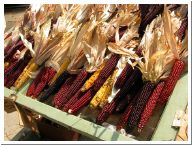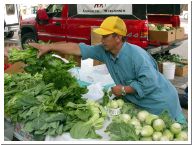
Our Local Dane County Farmer’s Market continues to be in the news. It is now recognized as the largest in the nation by the North American Farmers’ Direct Marketing Association, and still growing, according to R.W. Apple, who visited recently:
Everything sold must be grown in Wisconsin, and the sellers must actually have participated in the production of the goods. On this glorious late-summer day, with the sky a soaring canopy of robin’s-egg blue, more than 300 farmers from 30-odd counties came to town, many of them driving through the night to get here by 6 a.m. (By comparison the Union Square Greenmarket in New York has only about 70 farmers in peak season, but it is part of a network of 47 such markets in 33 locations in the city.)
The last of summer’s bounty was mingled on the stands with fall fruits and the first tender root crops of winter. The growers said it had been a wet summer, bad for tomatoes, but you couldn’t tell from those offered by Thomas M. Eugster of Old Stage Vegetable Gardens in Brooklyn, Wis., south of Madison. The tiny yellow Sungolds and the scarlet Goliaths, big as softballs, could not possibly have been sweeter.
“Look at them,” said a shopper to his wife. “With those gigantic T’s you could make a BLT without any B or L.”
There’s more local flavor:
But the king of this particular mountain is Richard deWilde of the all-organic Harmony Valley Farms near the pretty town of Viroqua, who loads a 20-foot truck every Friday night and leaves for Madison at 2:30 Saturday morning, arriving about 5:30. On a beautiful day, he might sell $6,000 worth of vegetables or more, but cold, rainy weather cuts that in half, he said, “and the food pantry” ? a charity ? “loves us.”
A bearded, keen-eyed, third-generation farmer whose grandfather was a buddy of J. I. Rodale, the pioneer organic farmer and publisher, Mr. deWilde grew up in South Dakota. He and his partner, Linda Halley, farm 90 acres planted in more than 60 kinds of vegetables with the help of their two sons and a number of hired hands. The farmers’ market, he said, is his “show window,” which has made the operation’s name in the region and has enabled him to sell to restaurants in Madison, Chicago and Minneapolis, and also to run a Community Supported Agriculture plan, in which 450 local households pay for weekly delivery of three-quarter bushel boxes of assorted produce.
Harmony Valley Farms has even broken into big-time mainstream commerce. Mr. deWilde sells several cool-climate specialties ? burdock, celeriac, daikon and three kinds of turnips ? to Albert’s Organics, a wholesaler in Bridgeport, N.J., and a broader range of vegetables to 18 Whole Food supermarkets in the Chicago area.
“Some of my friends at the farmers’ market complain about that,” he said, “but they help to keep me going. They pay on time, and above market price.”








